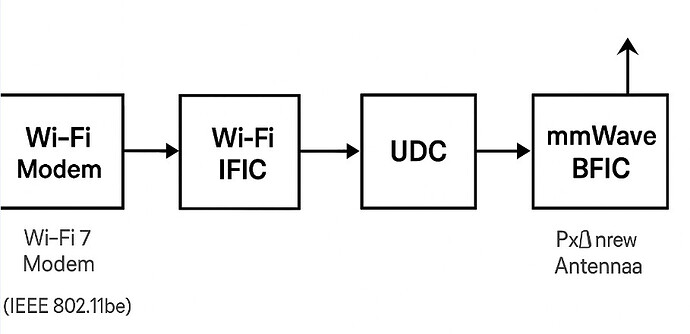To bridge the digital divide and meet the exploding demand for high-capacity broadband, especially in hard-to-reach locations, telecom innovators are exploring the use of Wi-Fi 6/7 (IEEE 802.11ax/802.11be) basebands over licensed mmWave (3GPP FR2) spectrum.**.
This hybrid solution offers a powerful mix of spectral efficiency, speed, and deployment flexibility—blending consumer-grade Wi-Fi technologies with carrier-grade propagation and planning techniques.
A particularly promising approach involves interfacing Wi-Fi 7 baseband with an up/down converter (UDC) to operate in the n258 band (26.5–29.5 GHz) — traditionally used by 5G New Radio. The result is a new class of Licensed-Based Radio (LBR) systems delivering fiber-like throughput via Fixed Wireless Access (FWA).
Architecture Overview
 Hardware Design Flow
Hardware Design Flow
- Wi-Fi 7 Baseband (802.11be):
- Up to 320 MHz channel bandwidth, 2x2 MIMO, 1024 QAM
- PHY throughput: up to 9.6 Gbps per AM7 module
- Intermediate Frequency Interface (IFIC):
- Converts baseband to 6 GHz intermediate frequency
- Up/Down Converter (UDC):
- Converts IF to mmWave range (26.5–27.5 GHz)
- Beamforming Interface Card (BFIC):
- Integrates PAs, LNAs and phased-array antennas for LOS mmWave propagation
 **P2P Backhaul for Enterprises and gNBs **
**P2P Backhaul for Enterprises and gNBs **
- 320 MHz channel per link with 2x2 + 2x2 stream configuration
- LOS Distance: up to 3 km
- Peak throughput: up to 3.5 Gbps (1024 QAM)
- Use Case: Fiber replacement or 5G NR gNB backhaul
 P2MP for Residential Access
P2MP for Residential Access
- One-to-many access serving up to 40 clients
- LOS Distance: up to 300 m
- Average Throughput per Access Point: 3.5 Gbps
- Homes per Access Point: Up to 210 homes @ 20 Mbps each
Ecosystem Evolution
Industry players such as Alpha Networks, Sercomm and Gemtek already have these hybrid devices using modular architectures.
Meanwhile, chipset vendors like ADI and Qualcomm are rumored to be building dedicated SoCs that will integrate:
- Baseband, UDC, beamforming
- Power control, PA calibration
- Channel estimation and beam tracking
This will reduce design complexity, lower cost, and speed up mass deployment.
Coexistence with 3GPP Radios: Challenges and Observations
Using 802.11be on 3GPP bands presents challenges around interference management and emission compliance, especially in dense or co-located deployments.
 Key Issues:
Key Issues:
- Adjacent Channel Interference (ACI)
- Spurious Emissions
- PA Non-linearities
- MAC Scheduling Asymmetry
- Beam Conflict in Dense Urban Environments
 Test-Based Coexistence Insights
Test-Based Coexistence Insights
To validate the real-world coexistence of LBR and 3GPP NR (n258), multiple test cases were conducted varying EIRP and frequency separation:
The Guard band between LBR and 3GPP NR radiating in same band
These results highlight that guard bands, power control and deployment distance are crucial for stable operation in shared mmWave environments.
Mitigation Recommendations
- Guard Band of ≥670 MHz for near-field deployments
- Power limiting to ≤45 dBm EIRP for co-located clients
- Directional beam shaping and interference-aware scheduling
- Dynamic Channel Selection (DCS) based on real-time feedback
- Smart coexistence algorithms in future SoCs
Conclusion
By combining the high throughput of Wi-Fi 7 (IEEE 802.11be) with the range and reliability of licensed mmWave spectrum, Licensed-Based Radio (LBR) introduces a cost-efficient, high-performance alternative for fixed wireless access (FWA). This architecture, which integrates a Wi-Fi modem, frequency up/down converters (UDC), and mmWave beamforming ICs (BFIC), delivers multi-gigabit backhaul for enterprises and mass-market access for homes, with flexible deployment in P2P and P2MP configurations.
On the enterprise side, point-to-point links can achieve up to 3.5 Gbps at distances of 3 km using 1024 QAM modulation. On the consumer side, point-to-multipoint configurations can serve up to 40 clients at 300 meters, enabling 210 homes per access point at an average of 20 Mbps each — all over licensed mmWave bands like n258 (26.5–27.5 GHz).
Coexistence Challenges
While the technology offers compelling capabilities, coexistence with 3GPP mmWave (5G NR) systems in adjacent or overlapping frequency bands requires detailed engineering:
- Guard Bands: As observed in testing, even with a 10 MHz guard band, high EIRP (~53 dBm) leads to mutual interference at close proximity (1 meter). Performance stabilizes with wider guard bands (≥340 MHz), and negligible impact is observed with 670 MHz separation below 51.5 dBm.
- Power Management: Reducing client EIRP from 53 dBm to 39 dBm in 2 dB steps showed strong improvements in coexistence, especially beyond 4 meters separation.
- Beam Planning & Isolation: Proper beam steering and antenna alignment reduce spatial interference.
- Emission Compliance: Adherence to ACLR, OBUE, and spurious emission limits from FCC, ETSI, and 3GPP standards is critical.
These coexistence strategies, validated through detailed testing, form a blueprint for hybrid network design in shared mmWave environments.
Economics: A Key Differentiator
Perhaps the most compelling aspect of LBR is its cost advantage:
Here’s a cost comparison table between a typical 3GPP mmWave system (Base Station and CPE) and a Licensed-Based Radio (LBR) system using Wi-Fi 7 baseband + UDC + mmWave front-end. These are approximate BOM-based costs for medium-scale volumes (10K–100K units), not retail pricing:
 Key Observations:
Key Observations:
- LBR hardware is 2.5x to 4x cheaper than 3GPP counterparts.
- Cost advantage is driven by use of Wi-Fi chipsets, simpler MAC/RRC stack, and no licensing costs for protocol stacks.
- Ideal for dense deployments, FWA, or enterprise backhaul, where capex constraints are tight.


